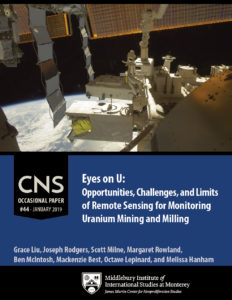January 16, 2019
Grace Liu, Joseph Rodgers, Scott Milne, Margaret Rowland, Ben McIntosh, Mackenzie Best, Octave Lepinard, and Melissa Hanham
The mining and milling of uranium does not generally receive the attention that the subject deserves. Yet this overlooked aspect of the nuclear fuel cycle can offer analysts important clues about a country’s fissile-material production. This, in turn, helps inform highly sensitive inquiries, such as estimates of arsenal size and potential for growth. Geospatial technology is uniquely helpful as a discovery and verification tool. The production of fissile material is often a closely held state secret; even for states that report production levels to the International Atomic Energy Agency, these numbers can be difficult to verify. Remote-sensing technology, such as satellite imagery paired with change-detection algorithms, can help pierce the veil of state secrecy and overcome physical barriers to inform analysts about this vital first step in the nuclear fuel cycle.
Occasional Paper #44—the final installment in a four-part series that uses open-source remote-sensing data to identify and monitor uranium mining and milling activities—examines these new tools and technologies in detail to demonstrate how analysts use them to detect, estimate, or verify uranium production. It explores different remote-sensing techniques and their various advantages, including traditional optical imagery, multispectral and hyperspectral images, and thermal and near-infrared images. It also discusses machine-learning algorithms as another tool for analysts examining large quantities of geospatial information in a relatively short amount of time.
Though these technologies hold great promise for WMD analysts, there are limitations to their use. CNS Occasional Paper #44 discusses these current and future limits, and concludes by calling for increased collaboration between the commercial satellite industry and analytical organizations and verification regimes alike, as a way for the nonproliferation regime to take advantage of these rapidly developing approaches.

